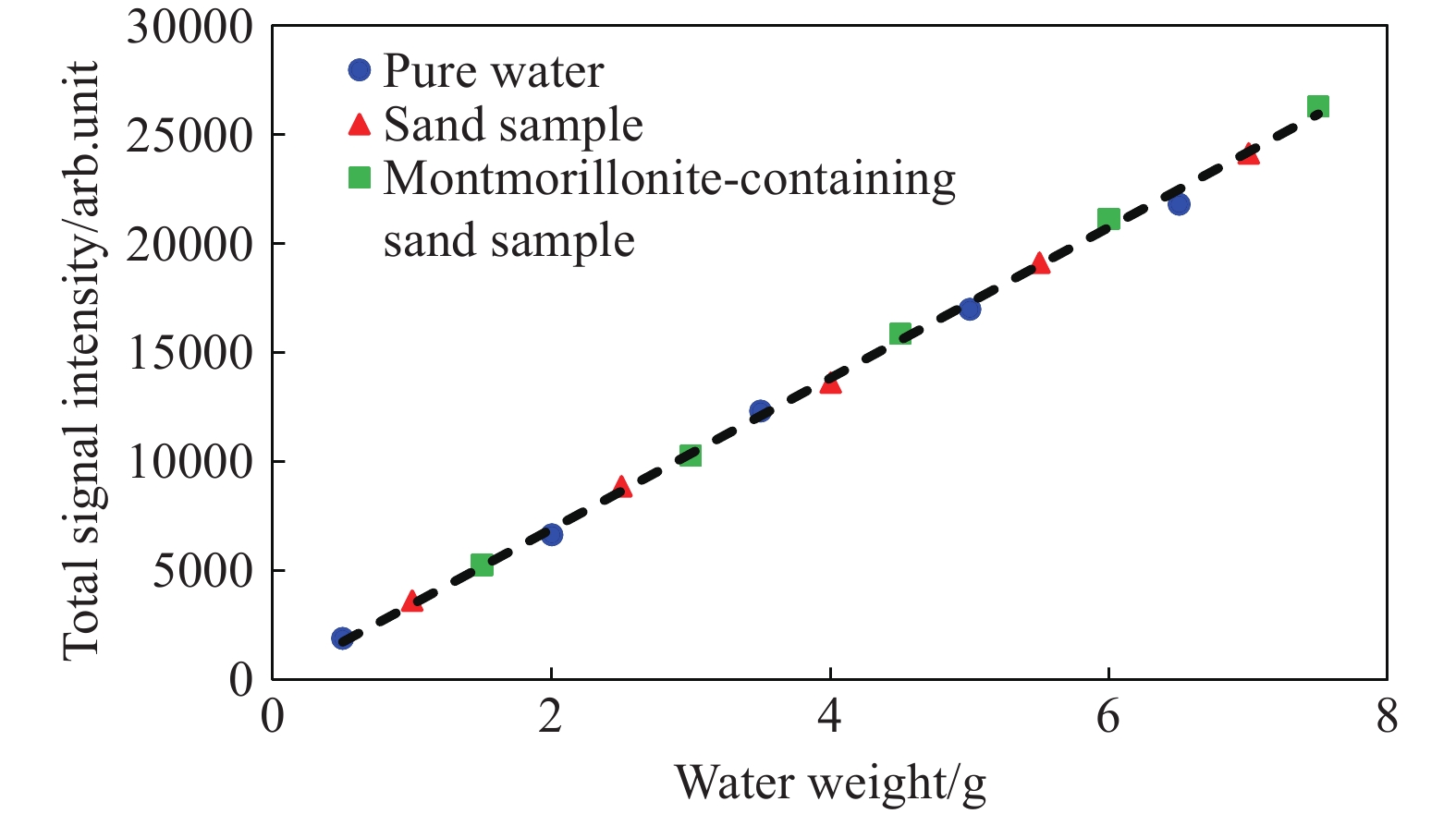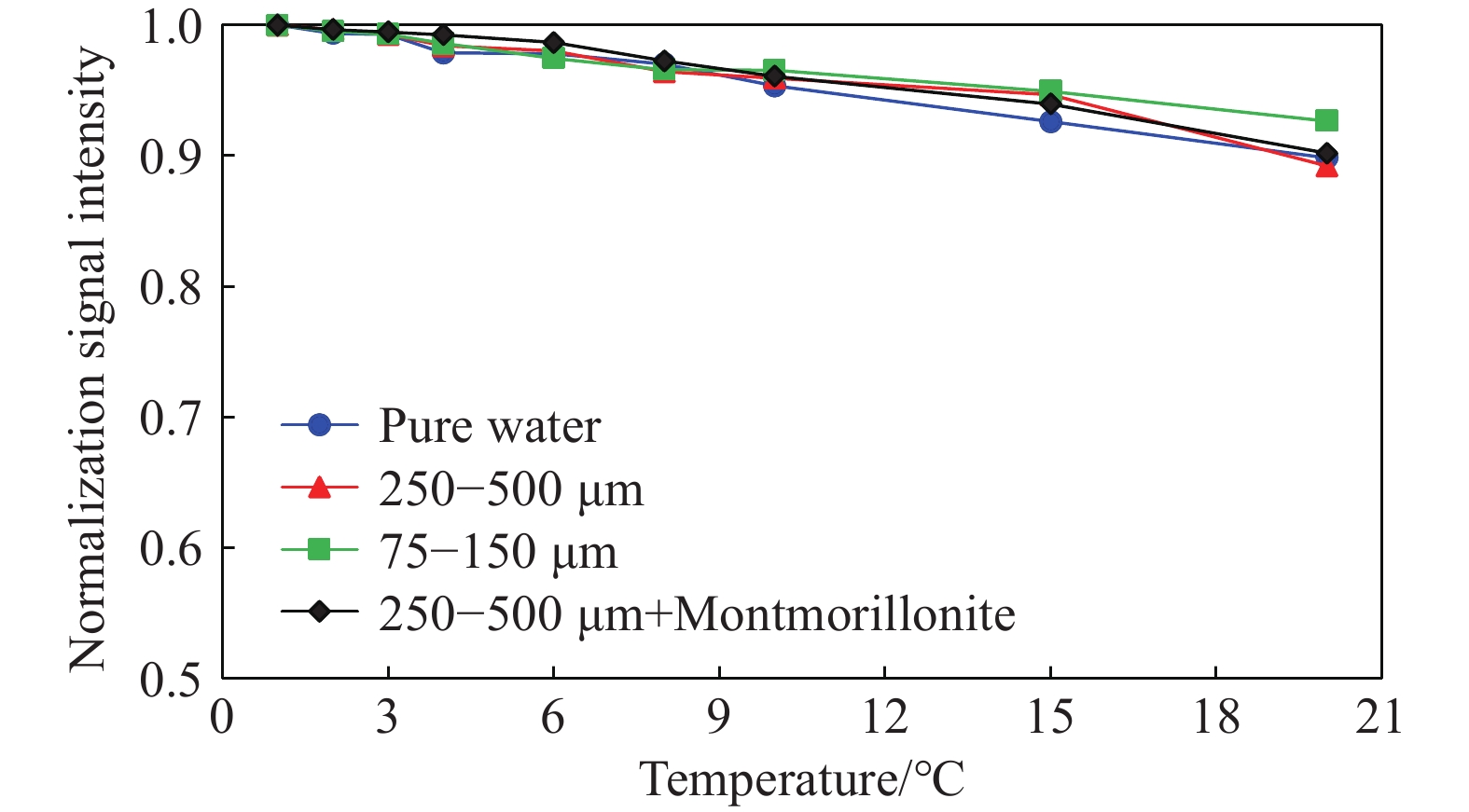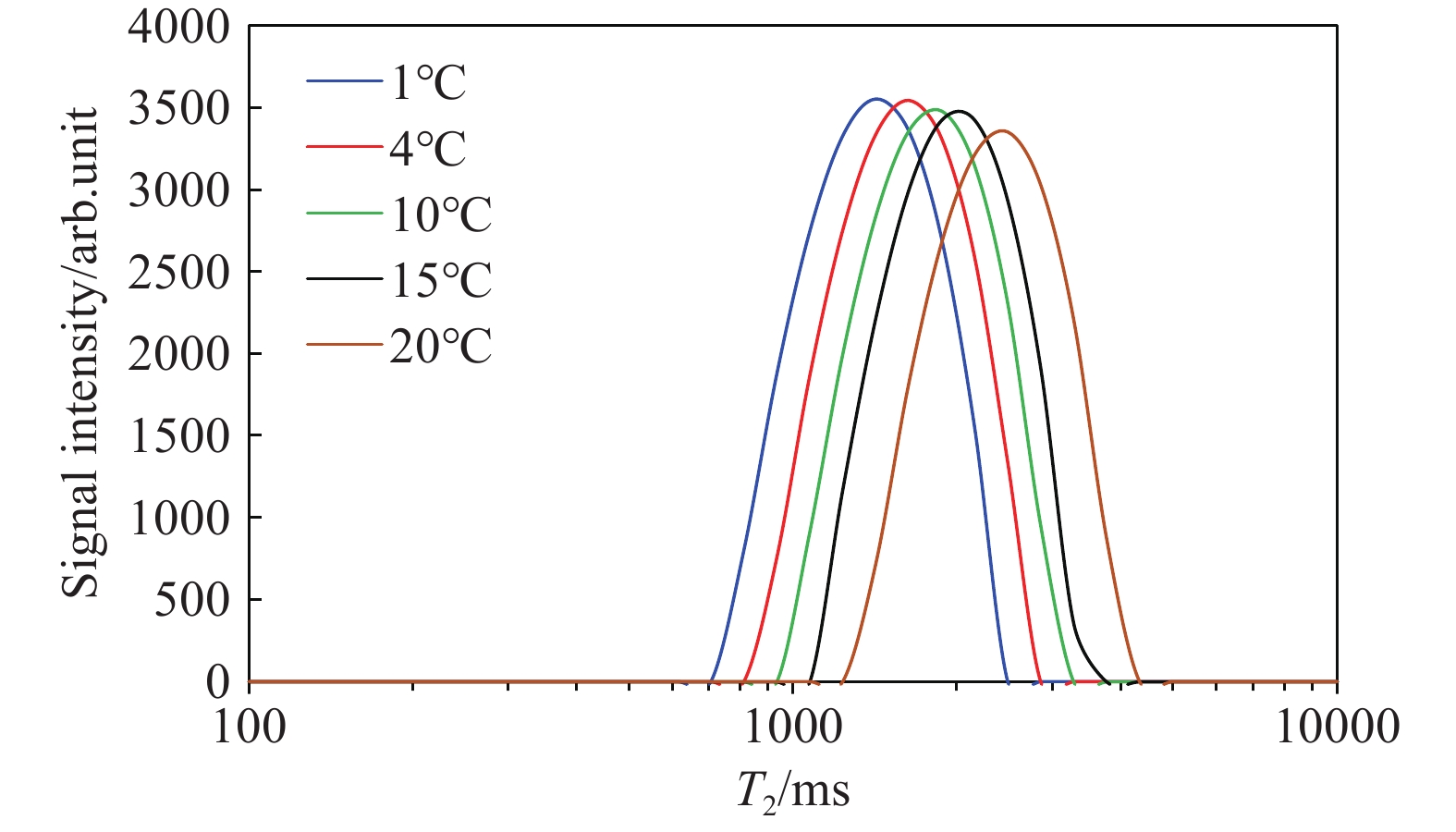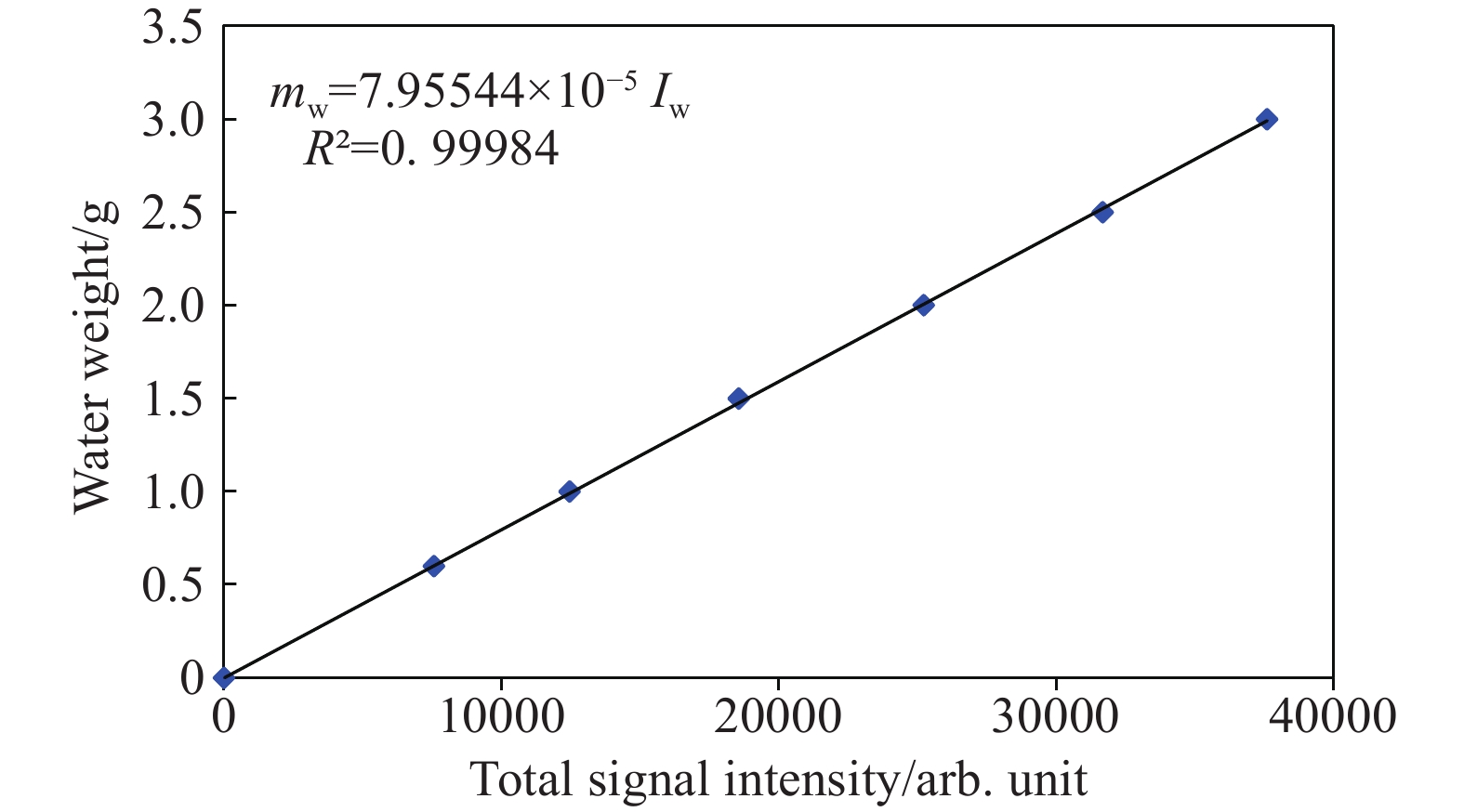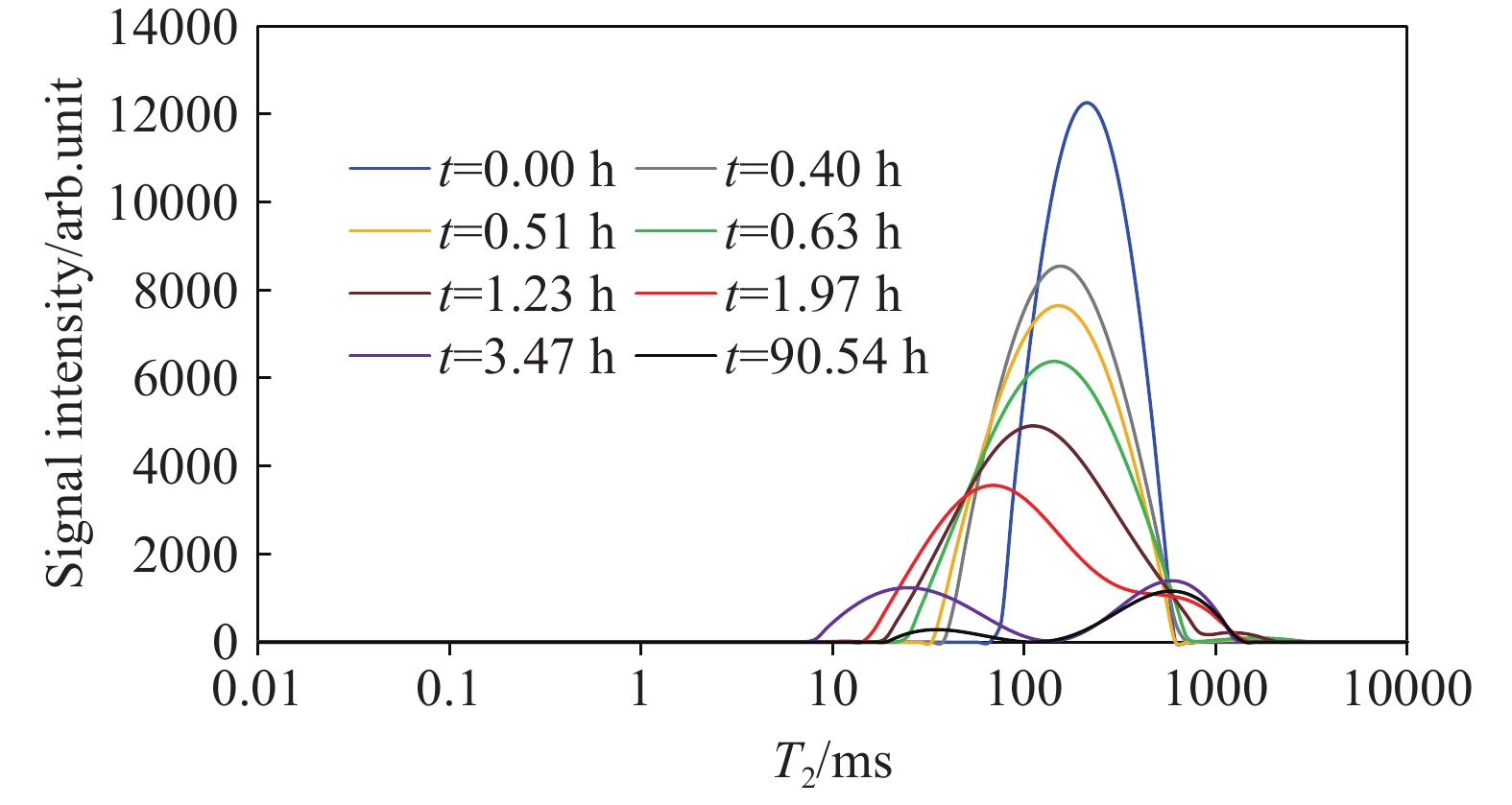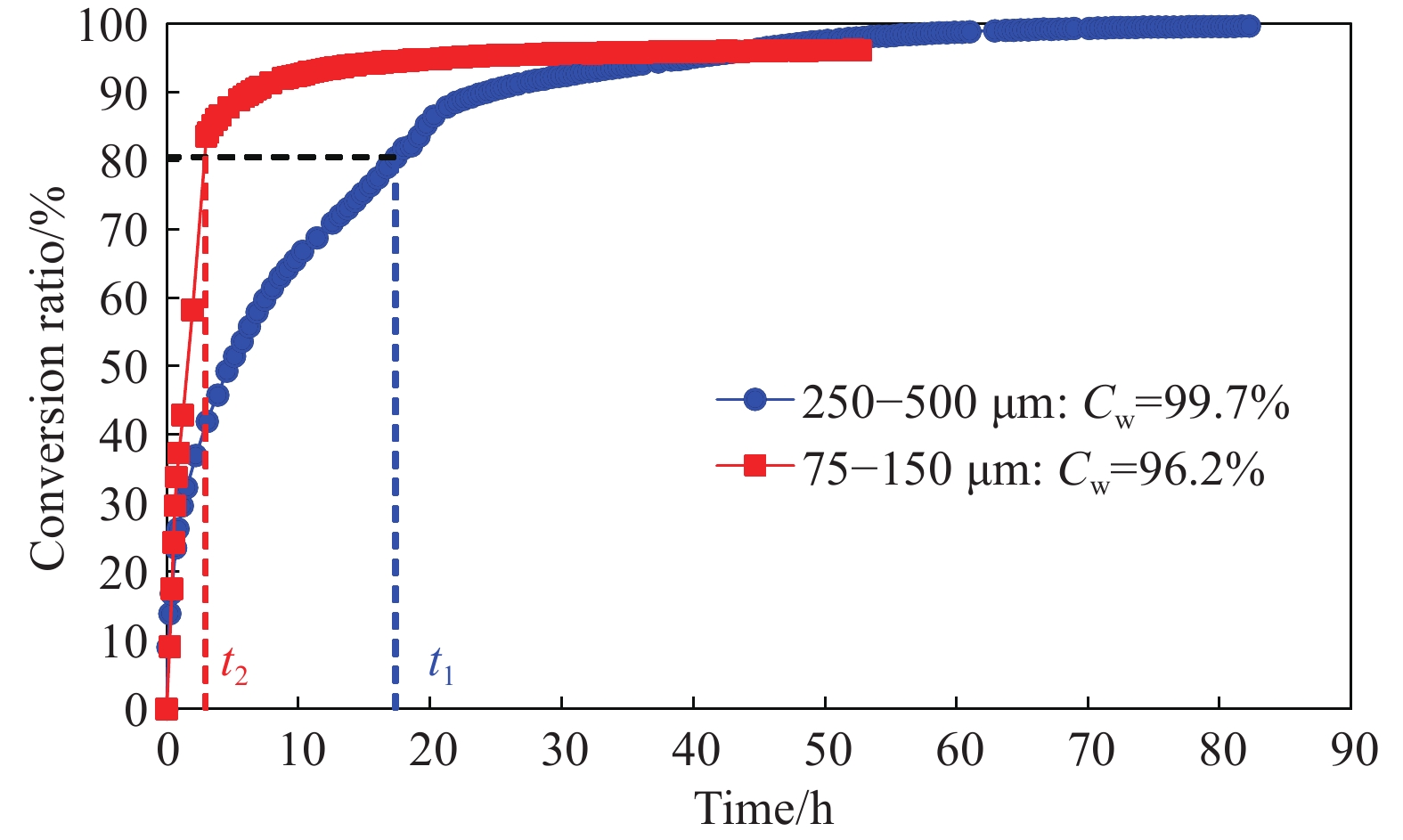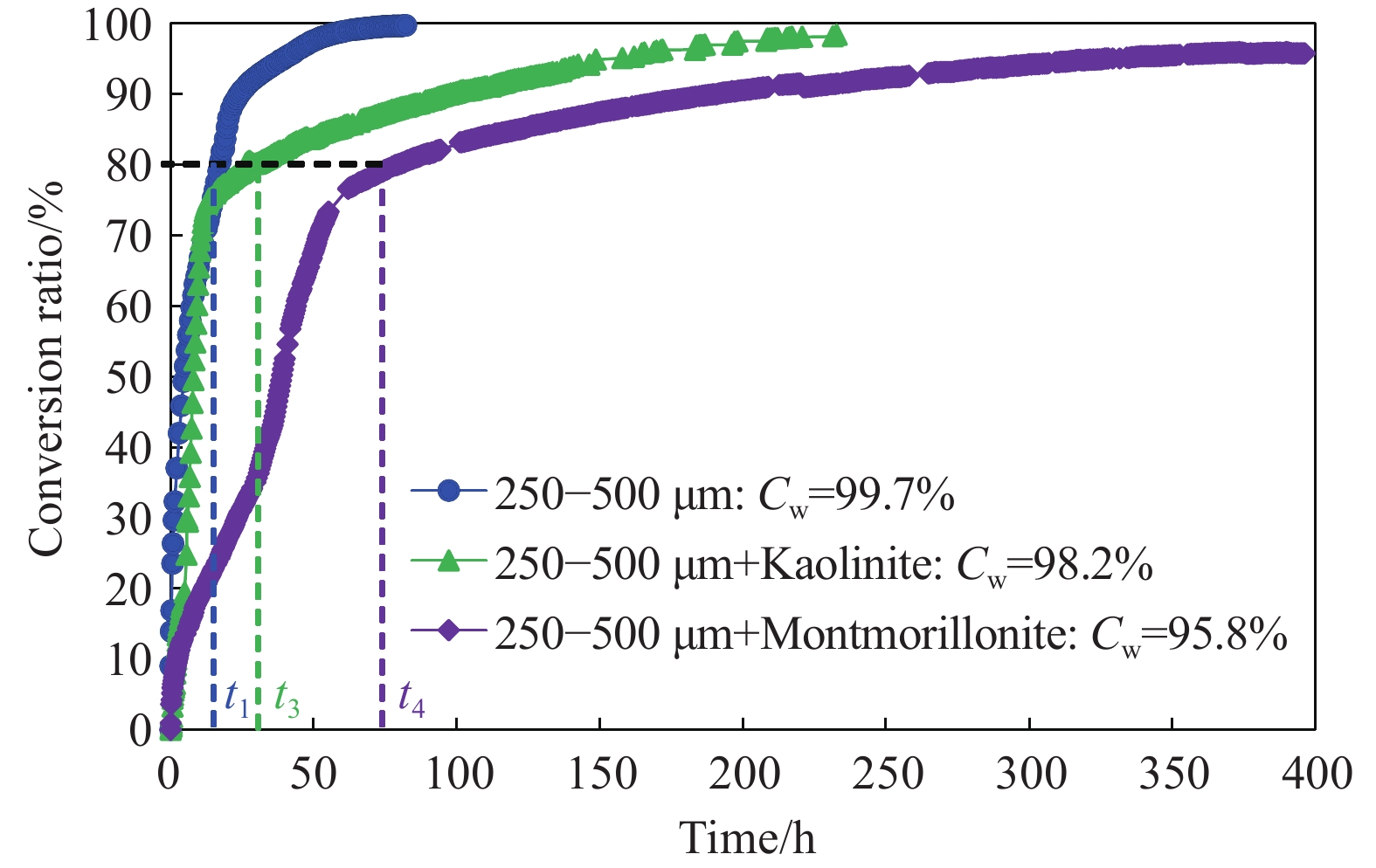| Citation: | Yun-kai Ji, Chang-ling Liu, Zhun Zhang, Qing-guo Meng, Le-le Liu, Yong-chao Zhang, Neng-you Wu, 2022. Experimental study on characteristics of pore water conversion during methane hydrates formation in unsaturated sand, China Geology, 5, 276-284. doi: 10.31035/cg2022013 |
Experimental study on characteristics of pore water conversion during methane hydrates formation in unsaturated sand
-
Abstract
Understanding the pore water conversion characteristics during hydrate formation in porous media is important to study the accumulation mechanism of marine gas hydrate. In this study, low-field NMR was used to study the pore water conversion characteristics during methane hydrate formation in unsaturated sand samples. Results show that the signal intensity of T2 distribution isn’t affected by sediment type and pore pressure, but is affected by temperature. The increase in the pressure of hydrogen-containing gas can cause the increase in the signal intensity of T2 distribution. The heterogeneity of pore structure is aggravated due to the hydrate formation in porous media. The water conversion rate fluctuates during the hydrate formation. The sand size affects the water conversion ratio and rate by affecting the specific surface of sand in unsaturated porous media. For the fine sand sample, the large specific surface causes a large gas-water contact area resulting in a higher water conversion rate, but causes a large water-sand contact area resulting in a low water conversion ratio (Cw=96.2%). The clay can reduce the water conversion rate and ratio, especially montmorillonite (Cw=95.8%). The crystal layer of montmorillonite affects the pore water conversion characteristics by hindering the conversion of interlayer water.
-

-
References
Bu QT, Hu GW, Ye YG, Liu CL, Li CF, Wang JS. 2017. Experimental study on 2-D acoustic characteristics and hydrate distribution in sand. Geophysical Journal International, 211(2), 990–1004. doi: 10.1093/gji/ggx351. Chen HL, Wei WF, Tian HH, Wei HZ. 2017. NMR relaxation response of CO2 hydrate formation and dissociation in sand. Acta Physico-Chimica Sinica, 33(08), 1599–1604. doi: 10.3866/PKU.WHXB201704194. Coates G, Xiao LZ, Prammer M. 1999. NMR Logging: Principles And Applications. Houston, Halliburton Energy Services, 35‒50. Cowan B. 1997. Nuclear Magnetic Resonance and Relaxation. Cambridge, Cambridge University Press. 83‒123 Ersland G, Husebø J, Graue A, Baldwin B, Howard J, Stevens J. 2010. Measuring gas hydrate formation and exchange with CO2 in Bentheim sandstone using MRI tomography. Chemical Engineering Journal, 158(1), 25–31. doi: 10.1016/j.cej.2008.12.028. Ge XM, Fan YR, Liu JY, Zhang L, Han YJ, Xing DH. 2017. An improved method for permeability estimation of the bioclastic limestone reservoir based on NMR data. Journal of Magnetic Resonance, 283, 96–109. doi: 10.1016/j.jmr.2017.09.004. Ge XM, Liu JY, Fan YR, Xing DH, Deng SG, Cai JC. 2018. Laboratory investigation into the formation and dissociation process of gas hydrate by low-field NMR technique. Journal of Geophysical Research:Solid Earth, 123(5), 3339–3346. doi: 10.1029/2017JB014705. Grunewald E, Knight R. 2011. The effect of pore size and magnetic susceptibility on the surface NMR relaxation parameter T2. Near Surface Geophysics, 2(9), 169–178. doi: 10.3997/1873-0604.2010062. Handa Y, Stupin D. 1992. Thermodynamic properties and dissociation characteristics of methane and propane hydrates in 70-ANG-radius silica gel pores. The Journal of Physical Chemistry, 96(21), 8599–8603. doi: 10.1021/j100200a071. Hou J, Ji YK, Zhou K, Liu YG, Wei B. 2018. Effect of hydrate on permeability in porous media: Pore-scale micro-simulation. International Journal of Heat and Mass Transfer, 126, 416–424. doi: 10.1016/j.ijheatmasstransfer.2018.05.156. Ji YK, Hou J, Cui GD, Lu N, Zhao EM, Liu YL, Du QJ. 2019. Experimental study on methane hydrate formation in a partially saturated sandstone using low-field NMR technique. Fuel, 251, 82–90. doi: 10.1016/j.fuel.2019.04.021. Ji YK, Hou J, Zhao EM, Liu CL, Guo TK, Liu YL, Wei B, Bai YJ. 2021. Pore-scale study on methane hydrate formation and dissociation in a heterogeneous micromodel. Journal of Natural Gas Science and Engineering, 95, 104230. doi: 10.1016/j.jngse.2021.104230. Jia JL, Zhang Y, Li G, Chen ZY, Li XS, Wu HJ. 2013. Experimental study on formation behavior of methane hydrate in sea mud from South China Sea. Geoscience, 27(06), 1373–1378. doi: 10.3969/j.issn.1000-8527.2013.06.014. Kenyon W. 1997. Petrophysical principles of applications of NMR logging. Log Analyst, 38(2), 21–40. Kleinberg R, Flaum C, Straley C, Brewer P, Malby G, Peltzer E, Friederich G, Yesinowski J. 2003. Seafloor nuclear magnetic resonance assay of methane hydrate in sediment and rock. Journal of Geophysical Research:Solid Earth, 108(B3), 2137. doi: 10.1029/2001JB000919. Kleinberg R, Flaum C, Griffin D, Brewer P, Malby G, Peltzer E, Yesinowski J. 2003. Deep sea NMR: Methane hydrate growth habit in porous media and its relationship to hydraulic permeability, deposit accumulation, and submarine slope stability. Journal of Geophysical Research:Solid Earth, 108(B10), 2508. doi: 10.1029/2003JB002389. Kuang YM, Zhang LX, Song YC, Yang L, Zhao JF. 2020. Quantitative determination of pore‐structure change and permeability estimation under hydrate phase transition by NMR. AIChE Journal, 66, e16859. doi: 10.1002/aic.16859. Li G, Li XS, Lv QN, Zhang Y. 2019. Permeability measurements of quartz sands with methane hydrate. Chemical Engineering Science, 193, 1–5. doi: 10.1016/j.ces.2018.08.055. Li JF, Ye JL, Qin XW, Qiu HJ, Wu NY, Lu HL, Xie WW, Lu JA, Peng F, Xu ZQ, Lu C, Kuang ZG, Wei JG, Liang QY, Lu HF, Kou BB. 2018. The first offshore natural gas hydrate production test in South China Sea. China Geology, 1(1), 5–16. doi: 10.31035/cg2018003. Li YL, Dong L, Wu NY, Nouri A, Liao HL, Chen Q, Sun JY, Liu CL. 2021. Influences of hydrate layered distribution patterns on triaxial shearing characteristics of hydrate-bearing sediments. Engineering Geology, 294, 106375. doi: 10.1016/j.enggeo.2021.106375. Liang HY, Guan DW, Yang L, Zhang LX, Song YC, Zhao JF. 2021. Multi-scale characterization of shell thickness and effective volume fraction during gas hydrates formation: A kinetic study. Chemical Engineering Journal, 424, 130360. doi: 10.1016/j.cej.2021.130360. Linga P, Daraboina N, Ripmeester J, Englezos P. 2012. Enhanced rate of gas hydrate formation in a fixed bed column filled with sand compared to a stirred vessel. Chemical Engineering Science, 68(1), 617–623. doi: 10.1016/j.ces.2011.10.030. Liu LL, Zhang Z, Liu CL, Wu NY, Ning FL, Zhang YC, Meng QG, Li CF. 2021. Nuclear magnetic resonance transverse surface relaxivity in quartzitic sands containing gas hydrate. Energy & Fuels, 35(7), 6144–6152. doi: 10.1021/acs.energyfuels.1c00225. Liu YZ, Zhang LX, Yang L, Dong HS, Zhao JF, Song YC. 2021. Behaviors of CO2 hydrate formation in the presence of acid-dissolvable organic matters. Environmental Science & Technology, 55(9), 6206–6213. doi: 10.1021/acs.est.0c06407. Mekala P, Babu P, Sangwai J, Linga P. 2014. Formation and dissociation kinetics of methane hydrates in seawater and silica sand. Energy & Fuels, 28(4), 2708–2716. doi: 10.1021/ef402445k. Minagawa H, Nishikawa Y, Ikeda I, Miyazaki K, Takahara N, Sakamoto Y, Komai T, Narita H. 2008. Characterization of sand sediment by pore size distribution and permeability using proton nuclear magnetic resonance measurement. Journal of Geophysical Research, 113(B7). doi: 10.1029/2007JB005403. Priegnitz M, Thaler J, Spangenberg E, Schicks J, Schrötter J, Abendroth S. 2015. Characterizing electrical properties and permeability changes of hydrate bearing sediments using ERT data. Geophysical Journal International, 202(3), 1599–1612. doi: 10.1093/gji/ggv245. Siangsai A, Rangsunvigit P, Kitiyanan B, Kulprathipanja S, Linga P. 2015. Investigation on the roles of activated carbon particle sizes on methane hydrate formation and dissociation. Chemical Engineering Science, 126, 383–389. doi: 10.1016/j.ces.2014.12.047. Sloan E, Koh C. 2008. Clathrate Hydrates of Natural Gases. Boca Raton, CRC Press, 156-168. Tohidi B, Anderson R, Clennell M, Burgass R, Biderkab A. 2001. Visual observation of gas-hydrate formation and dissociation in synthetic porous media by means of glass micromodels. Geology, 29(9), 867. doi: 10.1130/0091-7613(2001)029<0867:VOOGHF>2.0.CO;2. Rouquerol J, Rodriguez-Reinoso F, Sing K, Unger KK. 1988. Characterization of Porous Solids. Amsterdam, Elsevier Science, 439–447. Wu Pe, Li YH, Sun X, Liu WG, Song YC. 2021. Mechanical characteristics of hydrate-bearing sediment: A review. Energy & Fuels, 35(2), 1041–1057. doi: 10.1021/acs.energyfuels.0c03995. Yan KF, Li XS, Chen ZY, Zhang Y, Xu CG, Xia ZM. 2019. Methane hydrate formation and dissociation behaviors in montmorillonite. Chinese Journal of Chemical Engineering, 27(5), 1212–1218. doi: 10.1016/j.cjche.2018.11.025. Ye JL, Qin XW, Xie WW, Lu HL, Ma BJ, Qiu HJ, Liang JQ, Lu JA, Kuang ZG, Lu C, Liang QY, Wei SP, Yu YJ, Liu CS, Li B, Shen KX, Shi HX, Lu QP, Li J, Kou BB, Song G, Li B, Zhang HE, Lu HF, Ma C, Dong YF, Bian H. 2020. The second natural gas hydrate production test in the South China Sea. China Geology, 3(2), 197–209. doi: 10.31035/cg2020043. Yin ZY, Moridis G, Tan H, Linga P. 2018. Numerical analysis of experimental studies of methane hydrate formation in a sandy porous medium. Applied Energy, 220, 681–704. doi: 10.1016/j.apenergy.2018.03.075. Zhan L, Wang Y, Li XS. 2018. Experimental study on characteristics of methane hydrate formation and dissociation in porous medium with different particle sizes using depressurization. Fuel, 230, 37–44. doi: 10.1016/j.fuel.2018.05.008. Zhang YC, Liu LL, Wang DG, Chen PF, Zhang Z, Meng QG, Liu CL. 2021a. Application of low-field nuclear magnetic resonance (LFNMR) in characterizing the dissociation of gas hydrate in a porous media. Energy & Fuels, 35(3), 2174–2182. doi: 10.1021/acs.energyfuels.0c03855. Zhang YC, Liu LL, Wang DG, Zhang Z, Li CF, Meng QG, Liu CL. 2021b. The interface evolution during methane hydrate dissociation within quartz sands and its implications to the permeability prediction based on NMR data. Marine and Petroleum Geology, 129, 105065. doi: 10.1016/j.marpetgeo.2021.105065. Zhang Z, Liu LL, Li CF, Liu CL, Ning FL, Liu ZC, Meng QG. 2021. A testing assembly for combination measurements on gas hydrate-bearing sediments using X-ray computed tomography and low-field nuclear magnetic resonance. Review of Scientific Instruments, 92(8), 85108. doi: 10.1063/5.0040858. Zhao EM, Hou J, Du QJ, Liu YG, Ji YK, Bai YJ. 2021. Numerical modeling of gas production from methane hydrate deposits using low-frequency electrical heating assisted depressurization method. Fuel, 290, 120075. doi: 10.1016/j.fuel.2020.120075. -
Access History

-
Figure 1.
Schematic diagram of the experimental apparatus
-
Figure 2.
Schematic diagram of the high-pressure reactor.
-
Figure 3.
The relationship between the total signal intensity of T2 distribution and water weight.
-
Figure 4.
The relationship between the normalization signal intensity of T2 distribution and temperature.
-
Figure 5.
T2 distributions of pure water at different temperature.
-
Figure 6.
The relationship between the normalization signal intensity of T2 distribution and pore pressure.
-
Figure 7.
The relationship between water weight and the total signal intensity of T2 distribution.
-
Figure 8.
The variation of the T2 distribution during methane hydrate formation in the fine sand sample.
-
Figure 9.
The variation of the water conversion ratio and rate during methane hydrate formation in the fine sand sample.
-
Figure 10.
The variation of the water conversion ratio during methane hydrate formation in the coarse and fine sand sample.
-
Figure 11.
The variation of the water conversion ratio during methane hydrate formation in the coarse and clay-containing sand sample.

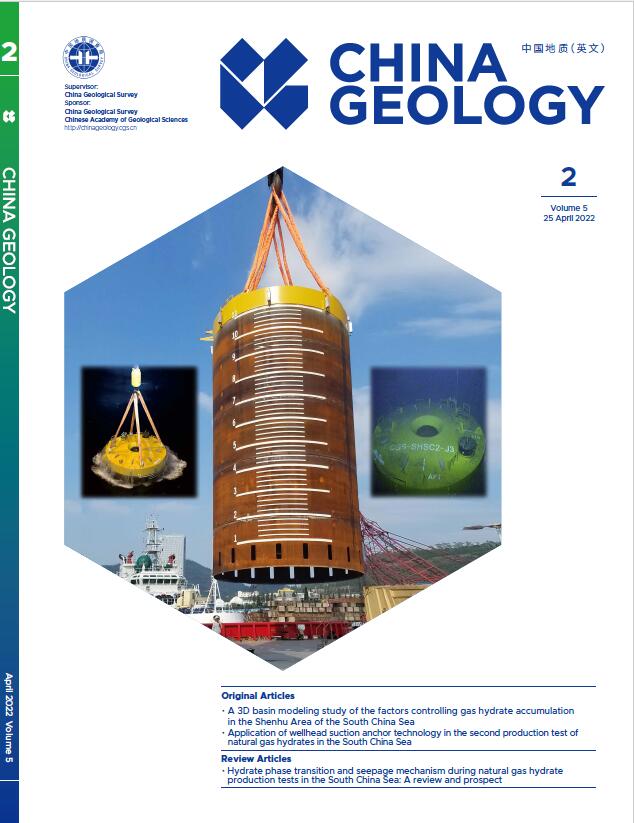

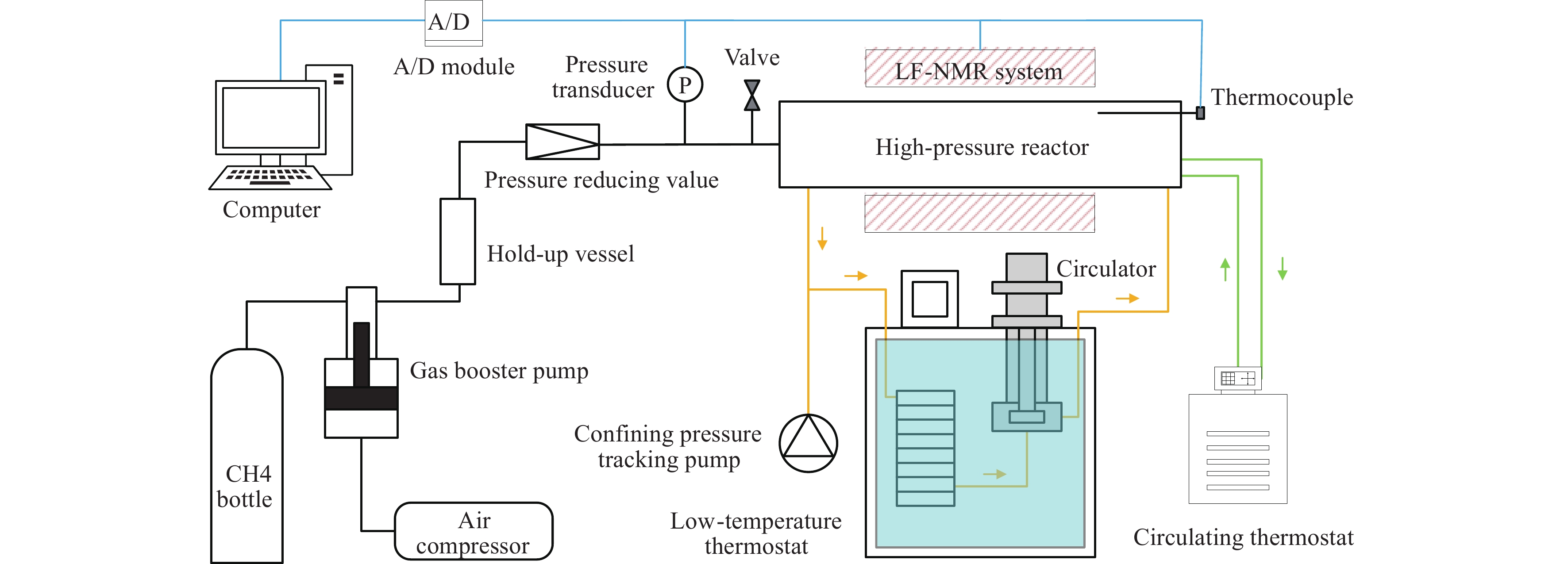

 DownLoad:
DownLoad:

